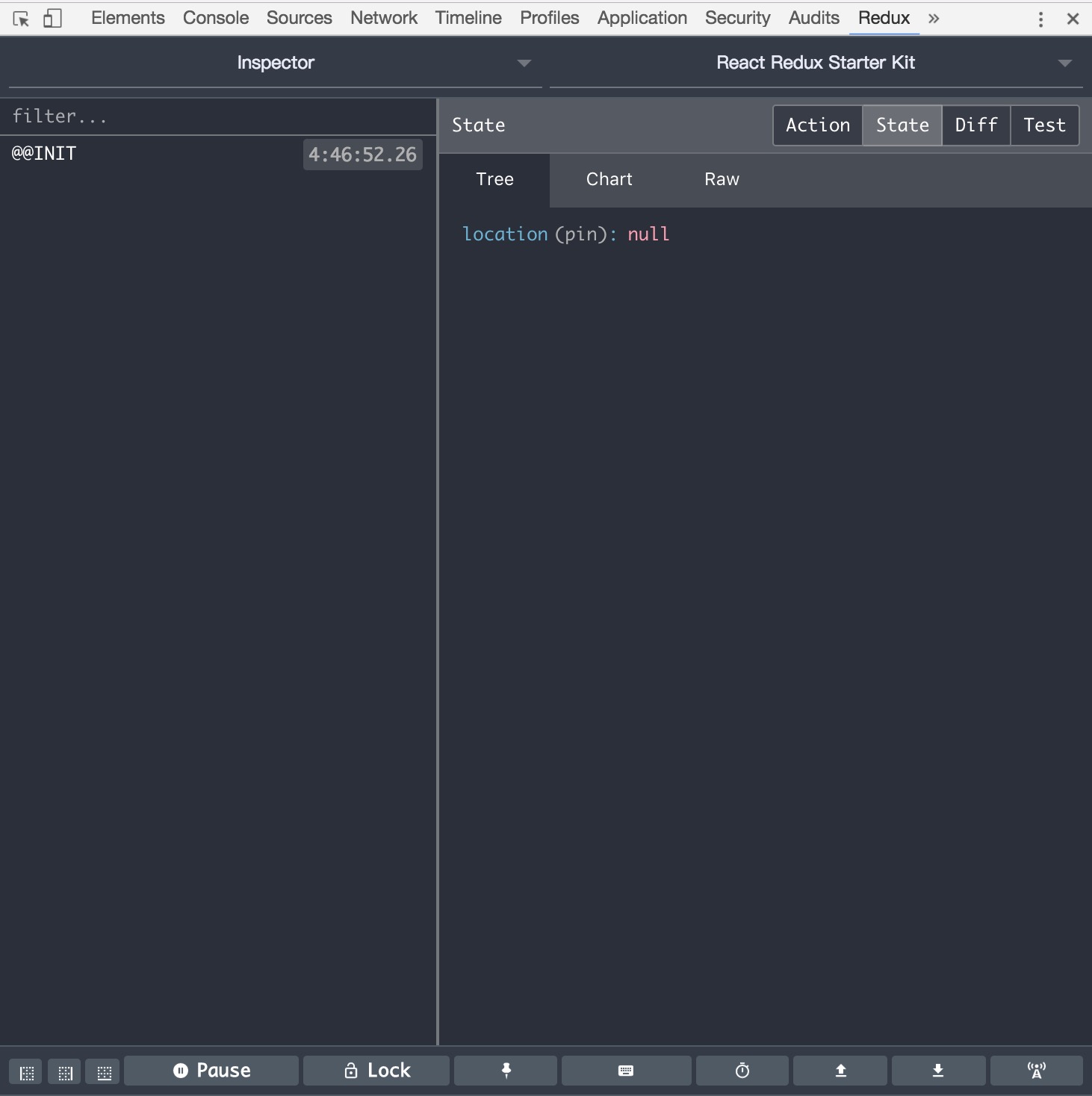
今天聊一聊 react + redux 环境快速搭建,以及实战一个 TodoList,可能是有史以来最简洁的方法哦,是不是很期待,当时橙子也是很吃惊这样的搭建速度。
本文适合有 react 和 redux 基础的同学看,当然你也可以看完本文去学基础。下面进入正题
快速搭建环境
没错,看过前面博客的同学猜到,我会选择各种 cli 工具,当然你可能猜错了,这里用的不是 create-react-app 这个 star 最多的构建工具。
这里我们用 react-redux-starter-kit
需要 node 4.5.0+ & npm 3.0.0+ 即可,首先
1
2
3
4
| git clone https://github.com/davezuko/react-redux-starter-kit.git <my-project-name>
cd <my-project-name>
npm install
npm start
|
没错你已经搭建环境完毕。好快的样子!
此时你可以看到 localhost:3000 的首屏了,welcome 然后一个鸭子,奇怪的首屏,作者说 duck 是 redux 的谐音,好吧。。。
此时可能你已经兴奋的点完了,这个 cli 的全部内容。
先不急看效果,既然是 redux,就要有对应的 chrome 插件,让我们直观的看到 store 的变化。
推荐 redux-devtool,点开链接,添加至 chrome 即可。
此时开启控制台,找到 Redux 的 tab,会看到如下界面

功能强大,想深入学习的可以看文档,这里我们只关心 Action 和 State 的变化
此时项目在 localhost:3000/counter 这个路由下有个累加器,Increment 每次同步加 1,Double(async) 每次异步乘 2。
异步处理速度慢?不是的看代码会发现这样一段
1
2
3
4
5
6
7
8
9
10
11
12
13
| export const doubleAsync = () => {
return (dispatch, getState) => {
return new Promise((resolve) => {
setTimeout(() => {
dispatch({
type : COUNTER_DOUBLE_ASYNC,
payload : getState().counter
})
resolve()
}, 200)
})
}
}
|
没错,是一个 200ms 的 setTimeout。
大家印象里,官方文档有说 action 是立即执行的同步函数,我们可以借助中间件的形式实现异步,这里用的是 redux-thunk,这种方式的确解决了问题,之后的文章还会单独介绍更好的办法。
代码简单过一遍,没什么难点。接下来我们就可以根据这个项目渐进开发了。
实战 TodoList
好,我们首先添加一个路由
src/compoments/Header/Header.js
在 div 标签内最下面添加如下代码
1
2
3
4
| {' · '}
<Link to='/todo' activeClassName='route--active'>
Todo
</Link>
|
src/routes/index.js
对应位置如下修改,添加一个子路由。
1
2
3
4
5
6
7
8
9
10
11
12
13
14
| import CoreLayout from '../layouts/CoreLayout'
import Home from './Home'
import CounterRoute from './Counter'
import TodoRoute from './Todo'
export const createRoutes = (store) => ({
path : '/',
component : CoreLayout,
indexRoute : Home,
childRoutes : [
CounterRoute(store),
TodoRoute(store)
]
})
|
我们现在还没有 Todo 对应路由的组件,下面在 routes 下创建 Todo 文件夹,然后文件夹结构如下
1
2
3
4
5
6
7
8
9
10
11
| Todo
|-components
| |-Todo.js
|
|-containers
| |-TodoContainer.js
|
|-modules
| |-todo.js
|
|-index.js
|
简单解释一下这个目录结构,index.js 是 Todo 作为路由页面的入口文件,components 下放的是模块的视图部分,containers 作为一个容器来绑定组件的 event、 state 和 prop,modules 主要是负责从 action->reducer->newState 的过程。
条例清晰,梳理完结构,看看每个文件都怎么完成的
index.js
1
2
3
4
5
6
7
8
9
10
11
12
13
14
15
16
17
| import { injectReducer } from '../../store/reducers'
export default (store) => ({
path : 'todo',
getComponent (nextState, cb) {
require.ensure([], (require) => {
const Todo = require('./containers/TodoContainer').default
const { itemReducer } = require('./modules/todo')
const { todoListReducer } = require('./modules/todo')
injectReducer(store, { key: 'itemData', reducer: itemReducer })
injectReducer(store, { key: 'todoList', reducer: todoListReducer })
cb(null, Todo)
}, 'todo')
}
})
|
这里将 store 和 reducer 绑定,将 store 注入到 /todo 的路由下的 props 中去
components/Todo.js
1
2
3
4
5
6
7
8
9
10
11
12
13
14
15
16
17
18
19
20
21
22
23
24
25
26
27
28
29
30
31
32
33
34
35
36
37
38
39
40
41
42
43
44
45
46
47
48
49
50
51
52
53
54
55
56
57
58
59
60
61
62
63
64
65
66
67
68
69
| import React, { Component } from 'react'
export default class Todo extends Component {
render () {
return (
<div>
<input
className='form-control'
style={{ marginBottom: '10px' }}
type='text' ref='input'
value={this.props.itemData}
onChange={(e) => this.handleChange(e)}
/>
<button
className='btn btn-primary btn-lg btn-block'
style={{ marginBottom: '10px' }}
onClick={(e) => this.handleSubmit(e)}
>
添加
</button>
<ul className='list-group'>
{
this.props.todoList.map((item, index) => {
return <li
className='list-group-item'
key={index}
>
{item}
<button
className='btn btn-default'
data-index={index}
onClick={(e) => this.handleDel(e)}
>
❌
</button>
</li>
})
}
</ul>
</div>
)
}
handleChange (e) {
const node = this.refs.input
const text = node.value.trim()
this.props.updateItem(text)
}
handleSubmit (e) {
const node = this.refs.input
const text = node.value.trim()
this.props.addItem(text)
this.props.updateItem('')
}
handleDel (e) {
const index = e.target.getAttribute('data-index')
this.props.delItem(Number(index))
}
}
Todo.propTypes = {
addItem: React.PropTypes.func.isRequired,
itemData: React.PropTypes.string.isRequired,
updateItem: React.PropTypes.func.isRequired,
delItem: React.PropTypes.func.isRequired,
todoList: React.PropTypes.array.isRequired
}
|
就是个简单的 jsx,这里后缀没有写成 .jsx 文件,因为 webpack 配置了解析规则,.js 文件也可以正常解析,这里的 onClick 事件写成了 => 箭头函数的形式,目的是为了锁定 this 的作用域,在 handle 函数内可以拿到 this。
containers/TodoContainer.js
1
2
3
4
5
6
7
8
9
10
11
12
13
14
15
16
| import { connect } from 'react-redux'
import { updateItem, addItem, delItem } from '../modules/todo'
import Todo from '../components/Todo'
const mapDispatchToProps = {
updateItem,
addItem,
delItem
}
const mapStateToProps = (state) => ({
itemData: state.itemData,
todoList: state.todoList
})
export default connect(mapStateToProps, mapDispatchToProps)(Todo)
|
这里通过一个 connect 方法,将组件的 props 进行绑定。
modules/todo.js
1
2
3
4
5
6
7
8
9
10
11
12
13
14
15
16
17
18
19
20
21
22
23
24
25
26
27
28
29
30
31
32
33
34
35
36
37
38
39
40
41
42
43
44
45
46
47
48
49
50
51
52
53
| export const UPDATE_ITEM = 'UPDATE_ITEM'
export const ADD_ITEM = 'ADD_ITEM'
export const DELETE_ITEM = 'DELETE_ITEM'
export function updateItem (item) {
return {
type: UPDATE_ITEM,
payload: item
}
}
export function addItem (item) {
return {
type: ADD_ITEM,
payload: item
}
}
export function delItem (index) {
return {
type: DELETE_ITEM,
payload: index
}
}
export const actions = {
updateItem,
addItem,
delItem
}
const ITEM_ACTION_HANDLERS = {
[UPDATE_ITEM]: (state, action) => action.payload
}
const LIST_ACTION_HANDLERS = {
[ADD_ITEM]: (state, action) => state.concat(action.payload),
[DELETE_ITEM]: (state, action) => state.filter((item, index) => {
return index !== action.payload
})
}
export function itemReducer (state = '', action) {
const handler = ITEM_ACTION_HANDLERS[action.type]
return handler ? handler(state, action) : state
}
export function todoListReducer (state = [], action) {
const handler = LIST_ACTION_HANDLERS[action.type]
return handler ? handler(state, action) : state
}
|
这里 reducer 运用两个数组方法 concat 和 filter,分别做拼接和删除操作,这里意遵循 redux 的官方文档在不修改原 state,而是返回新的 state。在底部将两个 reducer 导出,绑定到 index.js 中。完成一个闭环,数据更新完成。
到这里我们的 todoList 完成了。
一边看界面一边看控制台 redux store 的变化吧!代码没有晦涩难懂的点,一个 todoList 也足以说明列表操作的流程,这也是各大框架都以 todoList 为 demo 的原因。
总结
对于复杂的应用 redux 带来的优势不赘述,本文的目的是讲述如何快速开发 react + redux 应用,让大家在配置环境上少踩坑,也通过一个简单的例子,说明我们应该怎么更简单的去使用 redux。动手写起来吧,橙子的文章一般都看不出效果的,亲手实现一遍会有意外收获哦,上面代码也是橙子自己踩过坑后写出来的,各大神有什么建议的地方尽管提出来!感谢阅读。

